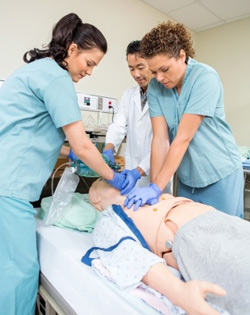BLS Stands for Basic Life Support. It is a set of techniques used on a victim to help maintain the victim’s life. When a person’s heart stops beating, the lack of oxygenated blood flowing through the body can cause brain damage in only a few minutes. A person may die within 8 to 10 minutes. If a victim’s breathing or heartbeat has stopped, BLS aims to keep the victim alive by manually pumping blood and oxygen through the victim’s body to the vital organs. This might sound a lot like CPR and it is.
 There are many situations where a rescuer might need to perform Basic Life Support (BLS) on a victim.
There are many situations where a rescuer might need to perform Basic Life Support (BLS) on a victim.
- The victim might be in Cardiac Arrest.
- The victim might be drowning
- The victim might be experiencing some sort of respiratory failure.
- The victim might be experiencing a heart attack or stroke
All these situations are serious and life threatening. When you encounter one of these situations, you must act right away.
What is the Difference Between CPR & BLS?
There is not much difference between the two. BLS is a term used at the professional level that indicates more complex CPR training for a medical professional. A professional medical worker such as a doctor, nurse, EMT, or fireman learns CPR with some added techniques that are only taught to medical professionals. This is BLS training. A medical professional might be required to take a Healthcare Provider BLScourse which is just an advanced CPR course for Healthcare Professionals. A regular person could take a basic CPR course.
Here are some of the differences between what a professional is taught and what a non-professional is taught.
-
- A non-professional might be taught to perform chest compressions ONLY. This is called Hands-Only CPR. A professional is taught to perform rescue breaths and chest compressions among other things.
Why doesn’t everyone learn to perform rescue breaths?
Studies have shown that bystanders are more willing to react if they have a simpler task to perform and if they don’t have to put their mouth on the mouth of a stranger. Studies show that it is better to do something (Chest compressions) than do nothing.
-
- A professional might learn 2-rescuer CPR. This is where one person performs rescue breaths and one person performs chest compressions at the same time.
2-rescuer CPR might be too complicated for the untrained professional.
- A professional might be taught to use specific tools that might be available in a hospital or doctor’s office but not in a public location.
The first thing to do in an emergency situation is call Emergency Response right away. That’s 9-1-1 in most place in the USA. Then it’s advised to assess the situation and perform CPR on an unresponsive victim only. If you are interested in learning more about CPR or BLS, consider taking our Free CPR/BLS Class. Hopefully this article has explained what BLS stands for.

